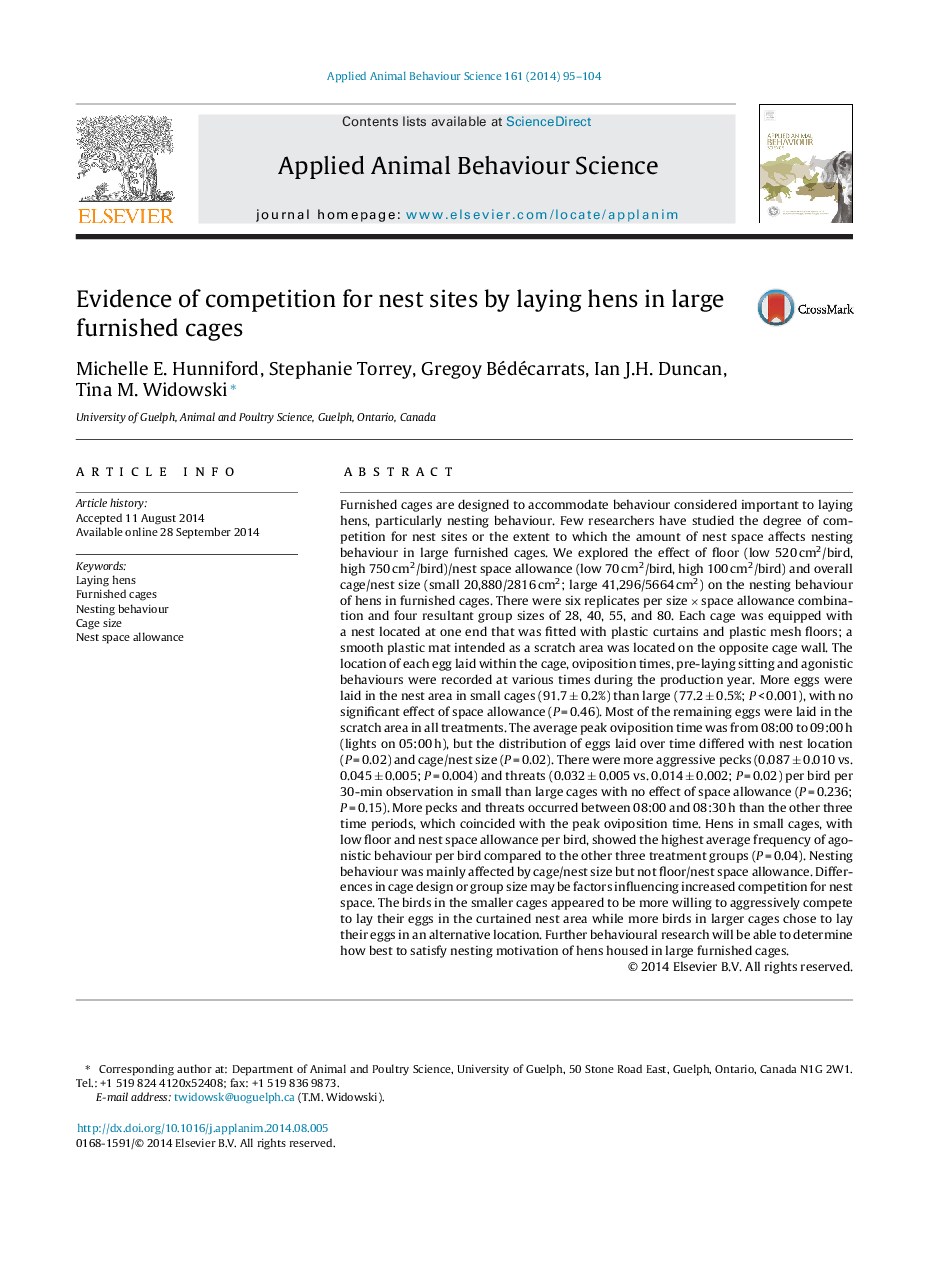| کد مقاله | کد نشریه | سال انتشار | مقاله انگلیسی | نسخه تمام متن |
|---|---|---|---|---|
| 4522517 | 1625345 | 2014 | 10 صفحه PDF | دانلود رایگان |
• Few studies have examined nesting behaviour of hens in large furnished cages.
• We examined effects of cage/nest size and space allowance on pre-laying behaviour.
• Cage size/design, not space allowance, affected nest use and time of oviposition.
• Agonistic behaviour corresponded with peak egg laying time, evidence for competition.
• Egg location alone is not a good indicator of sufficient nest space or design.
Furnished cages are designed to accommodate behaviour considered important to laying hens, particularly nesting behaviour. Few researchers have studied the degree of competition for nest sites or the extent to which the amount of nest space affects nesting behaviour in large furnished cages. We explored the effect of floor (low 520 cm2/bird, high 750 cm2/bird)/nest space allowance (low 70 cm2/bird, high 100 cm2/bird) and overall cage/nest size (small 20,880/2816 cm2; large 41,296/5664 cm2) on the nesting behaviour of hens in furnished cages. There were six replicates per size × space allowance combination and four resultant group sizes of 28, 40, 55, and 80. Each cage was equipped with a nest located at one end that was fitted with plastic curtains and plastic mesh floors; a smooth plastic mat intended as a scratch area was located on the opposite cage wall. The location of each egg laid within the cage, oviposition times, pre-laying sitting and agonistic behaviours were recorded at various times during the production year. More eggs were laid in the nest area in small cages (91.7 ± 0.2%) than large (77.2 ± 0.5%; P < 0.001), with no significant effect of space allowance (P = 0.46). Most of the remaining eggs were laid in the scratch area in all treatments. The average peak oviposition time was from 08:00 to 09:00 h (lights on 05:00 h), but the distribution of eggs laid over time differed with nest location (P = 0.02) and cage/nest size (P = 0.02). There were more aggressive pecks (0.087 ± 0.010 vs. 0.045 ± 0.005; P = 0.004) and threats (0.032 ± 0.005 vs. 0.014 ± 0.002; P = 0.02) per bird per 30-min observation in small than large cages with no effect of space allowance (P = 0.236; P = 0.15). More pecks and threats occurred between 08:00 and 08:30 h than the other three time periods, which coincided with the peak oviposition time. Hens in small cages, with low floor and nest space allowance per bird, showed the highest average frequency of agonistic behaviour per bird compared to the other three treatment groups (P = 0.04). Nesting behaviour was mainly affected by cage/nest size but not floor/nest space allowance. Differences in cage design or group size may be factors influencing increased competition for nest space. The birds in the smaller cages appeared to be more willing to aggressively compete to lay their eggs in the curtained nest area while more birds in larger cages chose to lay their eggs in an alternative location. Further behavioural research will be able to determine how best to satisfy nesting motivation of hens housed in large furnished cages.
Journal: Applied Animal Behaviour Science - Volume 161, December 2014, Pages 95–104
